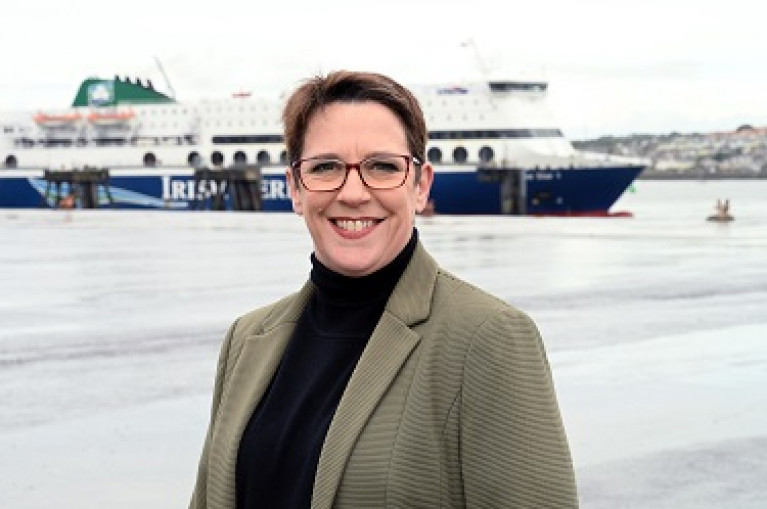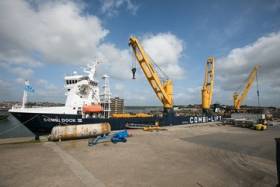Displaying items by tag: Pembroke Port
In South Wales, Pembroke Port, which is owned and operated by the Port of Milford Haven, has welcomed the first customer to its new workboat pontoons.
The infrastructure was installed as part of the Pembroke Dock Marine project to modernise the Port’s infrastructure, the pontoons are available for use by a range of vessels including workboats, barges and other small vessels.
CRC Sentinel, a dive support vessel owned by Commercial Rib Charter which is undertaking work on the Milford Haven Waterway, was the first to use the new pontoons.
Sharon Adams, Commercial Manager for Pembroke Port commented: “It’s great to see these new assets being utilised. Pembroke Port is perfectly positioned within the Port of Milford Haven to act as a hub for operations associated with marine activity taking place within the Port and the Celtic Sea. The pontoons are available for short and long term berthing and have secure access, as well as electricity and water hook ups.The workboat pontoons compliment the other infrastructure upgrades we made as part of the Pembroke Dock Marine project including new laydown space and an expanded slipway.
"We look forward to working with our existing customers, and welcoming new ones, to use the new facilities at Pembroke Port.”
The new infrastructure at Pembroke Port forms part of the Pembroke Dock Marine project to create a world-class energy and engineering centre of excellence and act as a focal point for capturing the economic value from wind, wave, and tidal renewable energy projects.
Alongside the Port’s own investment, Pembroke Dock Marine – a Swansea Bay City Deal project - is part funded by the UK Government and the European Regional Development Fund through the Welsh Government as well as other private sector partners.
During the construction, the project supported over 50 jobs including 6 apprenticeships. Contractors BAM, Walters Group and R&M Williams undertook community activity during the project, with the local community benefiting from over £11m local spend.
New Commercial Manager Joins South Wales Port Team
In south Wales, the Port of Milford Haven has appointed a new commercial manager for Pembroke Dock.
The appointment of Sharon Adams as the port's new Commercial Manager will be a key part to develop growing markets and support existing customers.
Sharon joins the port in Pembrokeshire from Chambers Wales where, most recently, she supported businesses with the changes required post-Brexit.
Previous to that Sharon’s career was predominantly in management roles within the hospitality and leisure industries with companies including The Parc by Thistle, St Brides Spa Hotel and Bluestone Resorts.
On joining the port, Sharon commented: “Learning more about the export and import markets really interested me, so when the opportunity to work with the Port came up I knew this was the right opportunity to put my commercial skills to good use. I’m very much looking forward to the challenge and the variety of businesses I’ll be working with.”
Commercial Director at the Port, Steve Edwards, said “Sharon has values that align to our culture and a wealth of commercial experience, and her latest role at Chambers Wales meant that she learnt a great deal about the movement of goods around the globe which puts her in an excellent position to help businesses grow whilst utilising our Pembroke site.”
Offshore Vessel Operator Establishes Base in South Wales Port
Marine renewables sector in south-west Wales, is to High Speed Tranfers Marine, an offshore vessel company, expand into Pembrokeshire after recognising the opportunities of the sector in the region.
HST Marine provides solutions in shipping, vessel management and chartering to industries throughout Europe from their headquarters in Swansea.
After learning at an industry event last year of the £60m Pembroke Dock Marine project, they now occupy an office and warehouse space in the heart of the development at Pembroke Port (see ferry deal) where they will be storing crew transfer vessels, RHIBs and workboats.
Site modifications are planned at Pembroke Port to create a modern port capable of delivering the needs of the marine energy and engineering sectors, including a deep-water slipway. Forming part of the ports' project as alluded, it will create the right conditions for job creation, skills development, supply chain resilience and economic growth.
CEO at HST Marine, Tom Nevin, sees this as a huge opportunity for Pembrokeshire. “Projects such as the Pembroke Dock Marine port infrastructure changes are crucial to HST’s current and long-term business plans. In order to expand, grow and compete with international companies, these types of projects are incredibly important and will help us to establish ourselves in south Wales” he said.
Tim James, Head of Commercial and Energy at the Port, has welcomed the team, commenting “HST Marine are bringing credible expertise and equipment to the growing cluster of specialists attracting year-round, well-paid employment opportunities into our community. Businesses like HST are recognising that Pembroke Dock, in particular, has the potential to play a major part in Wales’ aspiration to meet net zero targets and we must evolve our assets to meet their needs and those of future generations.”
Pembroke Dock Marine is funded by the Swansea Bay City Deal, the European Regional Development Fund through the Welsh Government, and through private investment.
Largest Cargoship to Berth At Welsh Port Exports Oil Refinery to Pakistan
#ports&shipping - Combi Dock III recently became the largest cargoship to visit Pembroke Port, Wales from where exported parts of a decommissioned oil refinery were loaded and bound for Pakistan.
The Murco refinery in Milford Haven closed in 2014 and is now owned by Puma Energy which runs it as a storage terminal.
Over the past year refinery parts have been transported by road to Pembroke Port for storage on the 69 acre site, with a team experienced in heavy lifts and unusual cargo, where the Combi Dock III was berthed. Additionally, a 201 tonne reactor was transported by the Terra Marique barge from Gelliswick Bay to Pembroke Port as it was too large to be moved by road.
The Combi Dock III is the largest vessel to berth at Pembroke Port, weighing in at 17,341 gross tons, measuring 162m in length with a beam of 25m. 3,239.94 tonnes of cargo is now on route to Pakistan; there it is expected to be reassembled. Two further exports of similar sizes are expected to take place over the next twelve to eighteen months.
Director of Quayside Operations at Pembroke Port, Natalie Britton, said “The movement of the refinery parts was well executed and the transfer onto the Combi Dock III ran smoothly. Our team provided moorings, berthing, quay space and laydown area, as well as safety inductions for the contractors on site. This is a prime example of how Pembroke Port can handle large and unusual size cargoes safely and efficiently.”
Afloat adds that Pembroke Port is predominently used as a ferryport by Irish Ferries Isle of Inishmore (34,000 gross tons) that serves the link to Rosslare.
There has been a ferry service between south Wales and Wexford since 1980 when the Pembrokeshire port was first developed for such operations. This involved the former Irish State owned shipping operator B+I Line running the route.
In more recent times, a berth nearby to the ferry linkspan, has been used to accommodate cruiseships.
Port Based Marine Power Device Cements Innovation Partnership
#PortWaveSub - An agreement between Marine Power Systems (MPS) following testing of key components of a pioneering wave powered renewable energy technology at Pembroke Port has been signed with the facility’s operator, the Port of Milford Haven.
The pump that is central to the concept of a pioneering WaveSub wave energy converter was tested in an onshore tidal lagoon at Pembroke Port. The pump will form part of the quarter size prototype that is now being developed by Swansea-based MPS. The WaveSub project has been part-funded by the European Regional Development Fund through the Welsh Government, with MPS receiving a £2 million grant in October 2015.
In a Memorandum of Understanding between MPS and the Port of Milford Haven, this will see deeper cooperation in WaveSub’s ongoing development. Wave energy is thought to hold great promise for delivering abundant renewable energy from the sea off the coast of Pembrokeshire and globally.
Due to the patent protected innovations of the WaveSub, it can be manufactured at commercial scale from a single facility in Wales and deployed throughout Europe.
Chief Executive of the Port of Milford Haven, Alec Don said, “Supporting companies with skills in the development of technologies and Intellectual Property is central to the Port’s strategy to promote a thriving marine renewable energy industry in the region.
“It’s great news to see Marine Power Systems go ahead with development of the WaveSub. It is just a few short months since Tidal Energy Ltd deployed their DeltaStream device, built here on the dockside, in the waters off the coast. Once again we are firmly committed to providing business support and help in kind and will be introducing MPS to some of the highly skilled companies the local supply chain can undoubtedly provide.”
Dr Gareth Stockman, co-founder and managing director of Marine Power Systems, said, “Marine Power Systems is hugely grateful to the Port of Milford Haven for its support. It has recently helped with the deployment and installation of the pump and it is great to know that they will be able to provide further assistance whilst manufacturing & deploying our ¼ scale prototype.”



























































